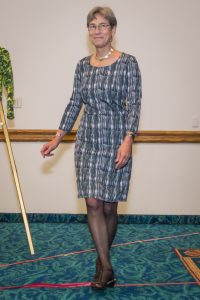
University of Utah ecologist Nalini Nadkarni is no fashion mogul. But she is a scientist actively engaged in public outreach, working to bring the wonder and curiosity of the natural world to people, even those who may have no interest in natural history museums, nature documentaries or natural history magazines.
Those people probably care about clothes, though.
On Aug. 8, Nadkarni and 14 other ecologists put on an unconventional fashion show at the annual meeting of the Ecological Society of America (ESA) in Fort Lauderdale, Florida. Each showcased a custom-made garment that artistically depicted his or her own field of research, the organism or environment to which they’d devoted their life and careers — their hearts on their sleeves.
In the special conference session, Nadkarni and her colleagues brought fashion and science together to demonstrate the creativity and collaborative spirit that should be the hallmark of scientific public outreach.

Nadkarni’s eco-fashion show arose from an idea that to engage members of the public in science, nature and conservation, scientists should try to connect with things that the public already cares about. She chose to focus on clothing and fashion.
Her first attempt to unite the two worlds was a cape made of actual moss she collected from field sites. The cape shed, however, and needed to be trimmed back once it started growing. Nadkarni turned instead to the idea of printing nature imagery on fabric.
She contacted U theatre professor and costume designer Brenda van der Wiel, who designed the fabric and garments, and who in turn enlisted tailor Eugene Tachinni, to fabricate the custom clothing. Having won approval for her special session at the 2016 ESA meeting, Nadkarni next faced the task of recruiting her models. She wanted the show to be taken seriously, and not perceived as a “goofy” diversion.
“What if I got the most respected, most eminent, most fantastic ecologists to be the models?” she said. She contacted current and former ESA officials, ESA fellows and National Science Foundation program officers. All enthusiastically said yes. Nadkarni was thrilled. Their participation could convey the message that public outreach is a core effort for all scientists. “Their stature would express and confirm what I was trying to say,” she said. Biology professor Lissy Coley and doctoral student La’Shaye Cobley, both of the U, also participated.
Some were less than familiar with fashion show conventions, however. “You mean we’re going to have to wear makeup?” one model reportedly said. “Well, I use ChapStick. Does that count?”

Van der Wiel and Tachinni interviewed each model, learning about their research and the organisms they studied, and then designed fabric patterns artistically depicting those organisms. “It wasn’t just a picture of a penguin on a T-shirt,” Nadkarni said. “I was blown away with how beautiful and meaningful these images became.”
Audience members at the show received a booklet detailing the stories behind each ecologist and each garment. As hosts Nadkarni and NSF program officer Douglas Levey recounted the models’ research accomplishments, hundreds of ecologists watched their colleagues present their skirts, jackets, dresses and even a hoodie, adorned with repeating patterns of leaves, oysters and, yes, penguins. Nadkarni said it was as close as possible to a real fashion show environment. “We didn’t get it completely right — we’re ecologists,” she said.
Van der Wiel and Tachinni spoke as well, describing their experiences learning about ecology and designing the pieces in the show. Van der Wiel was initially skeptical that scientists would be interested in fashion, but discovered a close link between art and science. Van der Wiel had never heard of diatoms or tapirs before, but said that as she worked on the project, “she understood that real scientists studied these things, and that it wasn’t so odd to her that they studied them because they were really beautiful and they invoke a sense of wonder,” Nadkarni reported. “No wonder they’re curious about them.”
Tachinni said he felt “stitched” now to the ecologists and their science, and motioned to the audience, saying he felt stitched to them as well. “All of us felt stitched together,” Nadkarni said. “We were open to the possibility that our worlds did overlap and should overlap.”
Afterwards the hosts encouraged the audience to consider their own work and chat with their neighbors about creative ways to connect with the public. Nadkarni described a “fantastic buzz” as the audience bounced ideas off each other, and then passed handwritten ideas forward. A dendrochronologist, for example, suggested turning tree rings into jewelry.
Some came to Nadkarni after the show and suggested that the eco-fashion show could be a traveling exhibit at natural history museums. Some suggested holding a show at the ESA meeting every other year. But the question she got most often: “Where can I buy the clothes?”
See more shots from the eco-fashion show here.
